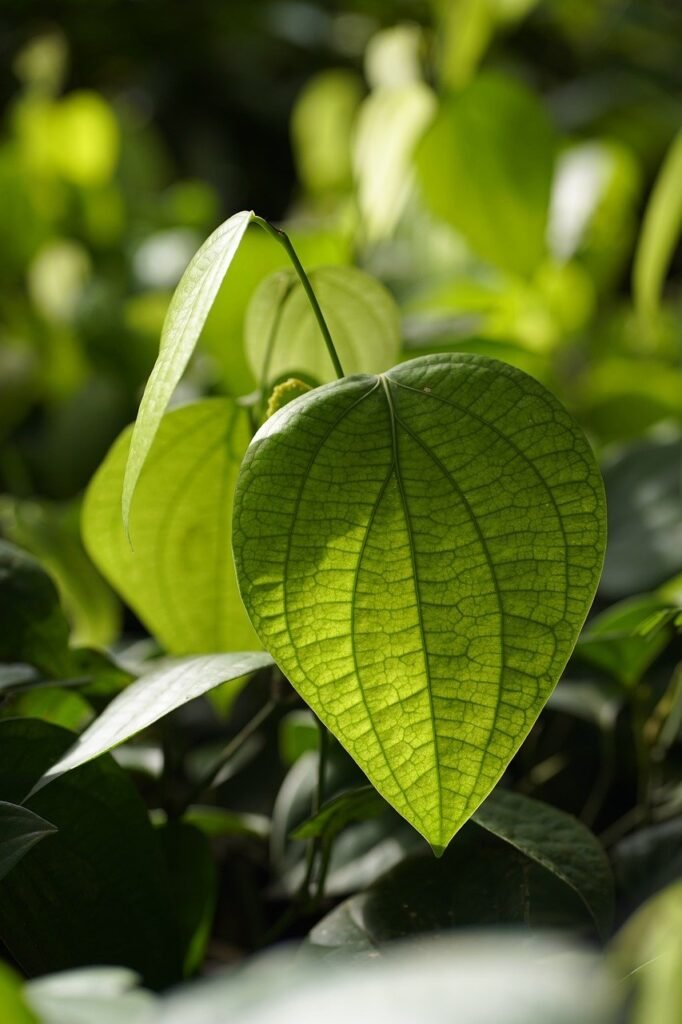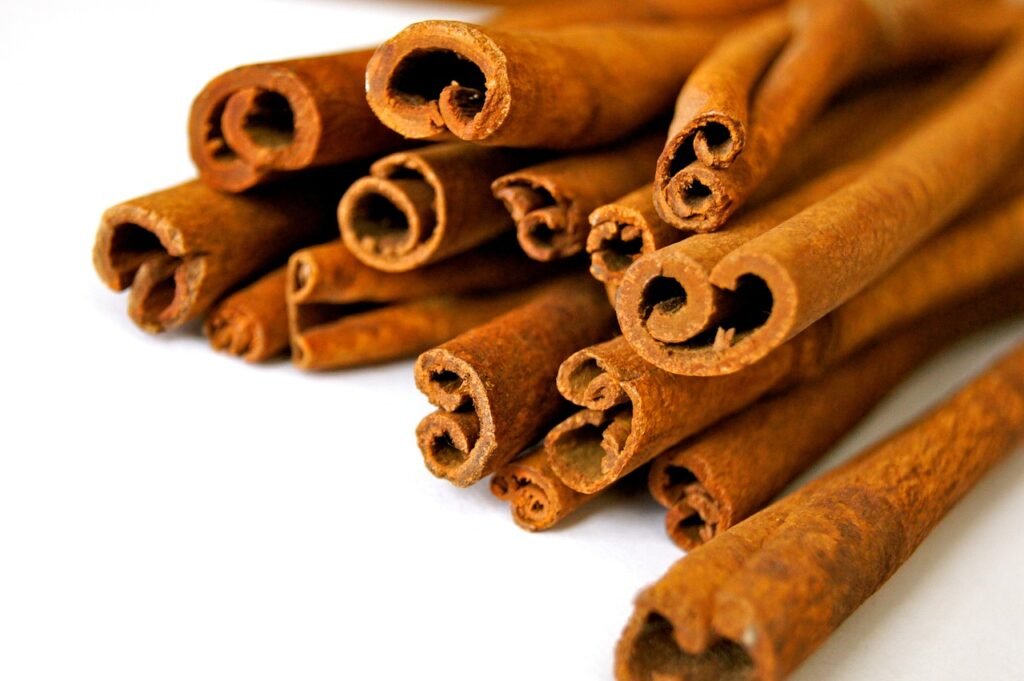Are you interested in the potential health benefits of spices? Well, you’re in for a treat! In this article, we will explore whether there are any spices known for their prebiotic properties. Prebiotics, as you may know, are substances that nourish the beneficial bacteria in our gut, promoting a healthy digestive system and overall well-being. So, grab a cup of tea, sit back, and let’s uncover the world of spices and their fascinating potential as prebiotics.

This image is property of pixabay.com.
Turmeric
Definition and background
Turmeric is a vibrant yellow spice that is widely known for its culinary and medicinal uses. It comes from the root of the Curcuma longa plant, which is native to South Asia. Turmeric has been used for centuries in traditional Ayurvedic medicine and is a staple in Indian cuisine. Its distinct flavor and vibrant color make it a popular addition to curries, sauces, and beverages.
Prebiotic properties of turmeric
In recent years, researchers have discovered that turmeric possesses prebiotic properties. Prebiotics are a type of dietary fiber that cannot be digested by the human body but serve as a source of nourishment for beneficial gut bacteria. These bacteria play a crucial role in maintaining a healthy gut microbiota, which is vital for overall digestive health and immune function.
Studies have found that turmeric contains compounds called curcuminoids, particularly curcumin, which act as prebiotics by promoting the growth and activity of beneficial gut bacteria. By nourishing these bacteria, turmeric helps support a balanced and diverse gut microbiome, which has been linked to numerous health benefits, including improved digestion, enhanced nutrient absorption, and a strengthened immune system.
Research studies
Several studies have investigated the prebiotic properties of turmeric and its potential health benefits. One study published in the Journal of Agricultural and Food Chemistry found that curcumin increased the growth of beneficial bacteria such as Lactobacillus and Bifidobacterium, while inhibiting the growth of harmful bacteria like Escherichia coli. Another study published in the journal Gut Microbes demonstrated that curcumin supplementation improved the diversity and composition of the gut microbiome in rats.
Ways to incorporate turmeric into your diet
Adding turmeric to your diet is easy and can be done in various ways. One popular method is using turmeric powder to season dishes like curries, soups, and stir-fries. You can also sprinkle it on roasted vegetables or blend it into smoothies for an added health boost. Another option is to enjoy a warm cup of turmeric tea by steeping turmeric powder or fresh turmeric slices in hot water and adding honey or lemon for flavor. Additionally, turmeric supplements are available for those who prefer a concentrated dose of curcumin.
Ginger
Definition and background
Ginger is another well-known spice that has been used in traditional medicine and culinary practices for centuries. It is derived from the rhizome of the Zingiber officinale plant, which is native to Southeast Asia. Ginger has a pungent and slightly sweet taste, making it a versatile ingredient in both savory and sweet dishes.
Prebiotic properties of ginger
Like turmeric, ginger also possesses prebiotic properties. It contains compounds called gingerols and shogaols, which have been found to stimulate the growth and activity of beneficial gut bacteria. These compounds act as prebiotics by providing nourishment to the gut microbiota and supporting their colonization in the digestive system.
Research studies
Several studies have explored the prebiotic effects of ginger. In a study published in the Journal of Agricultural and Food Chemistry, researchers found that ginger significantly increased the populations of beneficial bacteria, such as Lactobacillus and Bifidobacterium, in the intestines of rats. Another study published in the journal Molecular Nutrition & Food Research showed that ginger extract enhanced the growth of probiotic bacteria and inhibited the growth of harmful bacteria, thus promoting a healthy gut microbiota.
Ways to incorporate ginger into your diet
Incorporating ginger into your diet can be done in a variety of ways. Grated or sliced ginger can be added to savory dishes like stir-fries, marinades, and soups. It can also be used in baking, adding a warm and spicy flavor to cookies, cakes, and bread. For a refreshing and healthy beverage, try making ginger tea by steeping fresh ginger slices in hot water and adding a squeeze of lemon or a touch of honey. Ginger can also be consumed in supplement form for those who prefer a more concentrated dose of its beneficial compounds.
Cinnamon
Definition and background
Cinnamon is a fragrant spice obtained from the inner bark of trees belonging to the Cinnamomum family. It has a sweet and warm taste and is commonly used in both sweet and savory dishes. Cinnamon is native to Sri Lanka but is now widely cultivated in various parts of the world, including India, Indonesia, and Vietnam.
Prebiotic properties of cinnamon
Cinnamon has been found to possess prebiotic properties, making it beneficial for gut health. It contains compounds such as cinnamaldehyde, which has been shown to enhance the growth and activity of beneficial gut bacteria, particularly Bifidobacterium and Lactobacillus. These bacteria play a crucial role in maintaining a healthy gut microbiota.
Research studies
Research studies have highlighted the prebiotic effects of cinnamon. A study published in the journal Food & Function found that cinnamon extract increased the populations of beneficial bacteria, such as Lactobacillus, in the intestines of mice. Another study published in the journal Nutrition Research showed that cinnamon supplementation decreased the levels of harmful bacteria and improved the diversity of the gut microbiota in overweight and obese individuals.
Ways to incorporate cinnamon into your diet
There are numerous ways to incorporate cinnamon into your diet. It can be sprinkled onto oats, yogurt, or smoothies for a flavorful and nutritious boost. Cinnamon can also be added to baked goods like muffins, pancakes, and bread, providing a warm and fragrant aroma. Additionally, cinnamon can be used to flavor savory dishes such as stews and curries. Experimenting with cinnamon in your cooking and baking can add a delightful twist to your favorite recipes while reaping its prebiotic benefits.
Garlic
Definition and background
Garlic is a pungent herb that belongs to the Allium family, which also includes onions, leeks, and shallots. It is cultivated worldwide and has been used for both culinary and medicinal purposes for centuries. Garlic has a characteristic flavor and aroma that intensify when it is minced or cooked, making it a versatile ingredient in various cuisines.
Prebiotic properties of garlic
Garlic contains a compound called inulin, which serves as a prebiotic by promoting the growth and activity of beneficial gut bacteria. Inulin is a type of dietary fiber that passes through the digestive system intact and reaches the colon, where it is fermented by the gut microbiota. This fermentation process produces short-chain fatty acids, which provide nourishment for the colon cells and help support a healthy gut environment.
Research studies
Numerous studies have investigated the prebiotic effects of garlic. One study published in the Journal of Agricultural and Food Chemistry found that garlic extract increased the populations of beneficial bacteria, such as Bifidobacterium and Lactobacillus, in the intestines of rats. Another study published in the journal Applied and Environmental Microbiology demonstrated that garlic supplementation improved the diversity of the gut microbiota in obese individuals.
Ways to incorporate garlic into your diet
Garlic can be used in countless recipes to add flavor and nutritional benefits. It can be sautéed with vegetables, added to marinades and dressings, or used as a seasoning for meat and seafood. Raw garlic can be included in homemade hummus or pesto for an extra kick of flavor. Roasting whole garlic cloves brings out a sweet and mellow taste, making them a delicious addition to spreads and dips. To enjoy the prebiotic properties of garlic, it is best to consume it raw or lightly cooked, as the beneficial compounds may be diminished with excessive heat.

This image is property of pixabay.com.
Cumin
Definition and background
Cumin is a spice derived from the Cuminum cyminum plant, which is native to the eastern Mediterranean region and Asia. It has been used in cooking for thousands of years and is particularly prevalent in cuisines from the Middle East, North Africa, and South Asia. Cumin has a warm and earthy flavor, adding depth and richness to various dishes.
Prebiotic properties of cumin
Cumin has been found to possess prebiotic properties, contributing to a healthy gut microbiota. It contains compounds such as fructooligosaccharides (FOS), which serve as prebiotics by promoting the growth and activity of beneficial gut bacteria. These bacteria help maintain a balanced gut microbiome and support digestive health.
Research studies
Studies exploring the prebiotic effects of cumin have shown promising results. A study published in the journal Food & Function found that cumin extract increased the populations of beneficial bacteria, including Lactobacillus and Bifidobacterium, in the intestines of mice. Another study published in the Journal of Applied Microbiology demonstrated that cumin essential oil exhibited antimicrobial activity against harmful bacteria while promoting the growth of beneficial bacteria.
Ways to incorporate cumin into your diet
Cumin can be incorporated into your diet in various ways to enjoy its prebiotic properties. It is commonly used as a spice in dishes such as curries, stews, and soups, adding a warm and aromatic flavor. Cumin can also be sprinkled onto roasted vegetables or used to season rice and couscous. Toasting whole cumin seeds before grinding them enhances their fragrance and flavor. Experimenting with cumin in your recipes offers a flavorful and nutritious way to support a healthy gut microbiome.
Cardamom
Definition and background
Cardamom is a spice derived from the seeds of plants belonging to the Elettaria and Amomum genera. Native to India and Sri Lanka, cardamom is highly valued for its intense aroma and unique taste. It is widely used in cuisines throughout the Middle East, India, and Scandinavia to flavor both sweet and savory dishes.
Prebiotic properties of cardamom
Cardamom possesses prebiotic properties due to its content of dietary fibers such as soluble fibers and resistant starch. These fibers are not digested by enzymes in the small intestines and instead reach the colon, where they serve as a food source for beneficial gut bacteria. By nourishing the gut microbiota, cardamom helps maintain a healthy balance of bacteria in the gut and supports digestive health.
Research studies
Limited studies have focused specifically on the prebiotic effects of cardamom. However, research on other spices with similar prebiotic properties suggests the potential benefits of cardamom. Soluble fibers and resistant starch, found in cardamom, have been linked to increased populations of beneficial gut bacteria and improved gut health. Further studies are needed to explore the specific prebiotic effects of cardamom on the gut microbiota.
Ways to incorporate cardamom into your diet
Cardamom can be incorporated into your diet in various ways to enjoy its prebiotic benefits. Ground cardamom can be used to flavor baked goods such as cookies, cakes, and bread. It adds a unique and aromatic twist to hot beverages like coffee, tea, and hot chocolate. Cardamom pods can also be crushed and added to rice dishes, curries, and desserts for a burst of flavor. Experimenting with cardamom in your cooking and baking can add a delightful and prebiotic-rich element to your meals.

This image is property of pixabay.com.
Fennel
Definition and background
Fennel is a flowering plant native to the Mediterranean region and is widely cultivated for its aromatic seeds and flavorful bulb. It has a distinctive anise-like taste and is used both as a culinary ingredient and in traditional medicine. Fennel seeds are often used as a spice and have a sweet, warm, and slightly licorice-like flavor.
Prebiotic properties of fennel
Fennel seeds contain a type of dietary fiber called fructans, which have prebiotic properties. Fructans are indigestible by human enzymes and reach the colon intact, where they are fermented by the gut microbiota. This fermentation process stimulates the growth and activity of beneficial gut bacteria, promoting a healthy gut environment.
Research studies
Research on the prebiotic effects of fennel is limited. However, studies on other prebiotic fibers, such as fructans, suggest the potential benefits of fennel seeds. Fructans have been shown to increase the populations of beneficial bacteria and enhance overall gut health. Further studies are needed to specifically investigate the prebiotic effects of fennel seeds on the gut microbiota.
Ways to incorporate fennel into your diet
Fennel can be incorporated into your diet in various ways to enjoy its prebiotic properties. Fennel seeds can be crushed or ground and used as a spice in bread, pastries, and spice blends. They can also be steeped in hot water to make a soothing and aromatic tea. Fennel bulb can be sliced and roasted, sautéed with vegetables, or added to salads, providing a refreshing and crunchy addition. Including fennel in your culinary repertoire allows you to add a prebiotic element to your meals while enjoying its unique flavor.
Black Pepper
Definition and background
Black pepper is one of the most commonly used spices worldwide and is known for its distinct spiciness. It comes from the berries of the Piper nigrum vine, which is native to South India. Black pepper has been used for centuries to enhance the flavor of various dishes and is a staple in many cuisines.
Prebiotic properties of black pepper
Black pepper contains a compound called piperine, which exhibits prebiotic properties. Piperine has been found to stimulate the growth and activity of beneficial gut bacteria, particularly Lactobacillus and Bifidobacterium. By promoting the growth of these bacteria, black pepper supports a healthy gut microbiota and digestive function.
Research studies
Research studies on the prebiotic effects of black pepper are limited. However, studies on piperine and other similar compounds suggest the potential prebiotic benefits of black pepper. Piperine has been shown to modulate the gut microbiota and improve intestinal health. Further studies are needed to explore the specific prebiotic effects of black pepper on the gut microbiota.
Ways to incorporate black pepper into your diet
Incorporating black pepper into your diet is simple and can be done in various ways. Ground black pepper can be used as a seasoning for savory dishes, adding a spicy kick and enhancing their flavor. It can also be sprinkled onto salads, roasted vegetables, or scrambled eggs for an extra burst of taste. Black pepper can be combined with other spices to create flavorful spice blends for marinades, rubs, and sauces. Experimenting with black pepper in your cooking allows you to enjoy its prebiotic properties while elevating the taste of your meals.
Coriander
Definition and background
Coriander, also known as cilantro or Chinese parsley, is an herb that is widely used in cooking throughout the world. It belongs to the Apiaceae family and is native to regions spanning from southern Europe to southwestern Asia. Coriander has a bright, citrusy flavor that adds freshness to a variety of dishes.
Prebiotic properties of coriander
Coriander contains certain fibers, such as fructans, which have prebiotic properties. These indigestible fibers reach the colon intact, where they serve as a food source for beneficial gut bacteria. By promoting the growth of these bacteria, coriander supports a healthy gut microbiota and digestive function.
Research studies
Studies specifically investigating the prebiotic effects of coriander are limited. However, research on similar prebiotic fibers, such as fructans, suggests the potential benefits of coriander. Fructans have been shown to increase the populations of beneficial gut bacteria and improve gut health. Further research is needed to explore the specific prebiotic effects of coriander on the gut microbiota.
Ways to incorporate coriander into your diet
There are numerous ways to incorporate coriander into your diet, allowing you to enjoy its prebiotic properties. Fresh coriander leaves can be chopped and added to salads, soups, and salsas to lend a vibrant and herbaceous flavor. Ground coriander seeds can be used as a spice in curries, marinades, and roasted vegetables, providing a warm and citrusy aroma. Coriander can also be blended into pesto or added to homemade dressings for a zesty and refreshing twist. Experimenting with coriander in your cooking allows you to add a prebiotic element to your meals while bringing out the natural flavors of your dishes.
Conclusion
Summary of spices with prebiotic properties
Incorporating spices with prebiotic properties into your diet can provide numerous health benefits. Turmeric, ginger, cinnamon, garlic, cumin, cardamom, fennel, black pepper, and coriander all possess prebiotic properties, promoting the growth and activity of beneficial gut bacteria.
Importance of incorporating prebiotic spices into the diet
Maintaining a healthy gut microbiota is essential for overall digestive health, nutrient absorption, and a strong immune system. The prebiotic properties of these spices help support a balanced and diverse gut microbiome, creating an optimal environment for beneficial bacteria to thrive. By incorporating these spices into your diet, you can enhance your overall gut health and well-being.
Future research and considerations
While research on the prebiotic properties of these spices is promising, more studies are needed to fully understand their effects on the gut microbiota and human health. Additionally, individual sensitivity and preferences may vary, so it is important to listen to your body and make choices that suit your needs and tastes.
Incorporating these prebiotic spices into your diet can be as simple as adding them to your favorite dishes or exploring new recipes that feature these flavors. Whether you choose to enjoy turmeric in a curry, ginger in a stir-fry, or cinnamon in your morning oatmeal, these spices offer a delicious and nourishing addition to your meals. Start experimenting with these prebiotic spices today and reap the benefits of a healthier gut and overall well-being.

